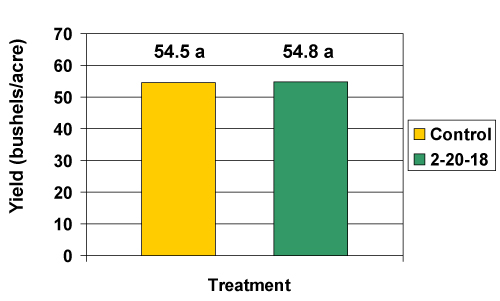Pop-up fertilizer effects on soybean yields in 2011
A summary of the results from eight on-farm research trials evaluating the effects of pop-up fertilizer on soybean yields in 2011.
There is tremendous interest in increasing soybean yields and producers are wondering if starter fertilizers can contribute to this goal. Because of this, the Soybean Management and Research and Technology (SMaRT) program conducted eight on-farm research trials in 2011 evaluating the effect of pop-up fertilizer on soybean yields. This article provides a summary of these trials.
A liquid fertilizer (NACHURS 2-20-18) applied in the seed furrow was compared to an unfertilized control in a randomized complete block experimental design with four replications. The pop-up fertilizer was applied at two gallons per acre in 30-inch rows and at four gallons per acre in 15-inch rows. Soil samples and stand counts were taken from all eight locations. Stand counts were taken 30 days after planting. Planting dates and soil test data for each site are presented in Table 1.
Table 1. Planting dates and soil test information for the 2011 pop-up fertilizer trials
|
Sanilac |
Sanilac |
Iosco |
Shiawassee |
Calhoun |
Sanilac |
Lapeer |
Huron |
|
|
Planting Date |
5/10 |
5/7 |
6/4 |
6/7 |
5/11 |
6/2 |
6/6 |
6/1 |
|
Phosphorus (ppm) |
79 |
27 |
48 |
47 |
142 |
57 |
43 |
73 |
|
Potassium (ppm) |
188 |
111 |
164 |
176 |
231 |
202 |
164 |
211 |
|
CEC (meq/100 g) |
8.3 |
12.2 |
5 |
7.8 |
7.7 |
15.1 |
9.6 |
12 |
Table 2. Pop-up fertilizer effects on soybean yields
|
Sanilac |
Sanilac |
Iosco |
Shiawassee |
Calhoun |
Sanilac |
Lapeer |
Huron |
|
|
Treatment |
---------------------------- Yield (bushels/acre) -------------------------- |
|||||||
|
NACHURS 2-20-18 |
61.0 a |
70.4 a |
44.8 a |
52.0 a |
56.2 a |
39.2 a |
55.1 a |
59.9 a |
|
Unfertilized Control |
57.9 b |
70.2 a |
43.7 a |
51.5 a |
56.9 a |
38.1 a |
55.9 a |
61.6 a |
|
C.V. (%) |
2.1 |
4.9 |
9.5 |
1.8 |
3.1 |
3.4 |
3.6 |
3.0 |
|
LSD 0.05 |
2.8 |
7.7 |
9.5 |
2.2 |
4.4 |
2.7 |
4.5 |
4.1 |
The pop-up fertilizer increased soybean yields significantly at one of the eight locations conducted in 2011 (Table 2). However, the pop-up did not significantly increase soybean yields at the other seven locations (Table 2) or when all eight sites were combined and analyzed (Figure 1). The pop-up fertilizer did not reduce plant populations when compared to the unfertilized control.
Figure 1. Pop-up fertilizer effects on soybean yields from eight locations in 2011.

Two factors determine the likelihood and size of a yield response from starter fertilizer: phosphorus and potassium soil test levels, and soil temperature. The phosphorus and potassium soil test levels are the most important factors determining soybean response to starter fertilizer. Economic returns to starter fertilizer are not likely to occur when phosphorus levels exceed 30 ppm and potassium levels exceed 130 ppm. The phosphorus and potassium soil test levels were above these levels at all but one site (not the responsive site). The soils were also relatively warm as five of the eight trials were planted in June and none of the trials were planted before May 7.
Placing fertilizer in contact with the seed increases the risk for salt injury. Salt injury is also more likely to occur if the fertilizer has a high salt index, if the soils are coarse-textured and if the soil is dry. Consider these factors when selecting fertilizers and application rates for pop-up fertilizers. Dr. Ronald Gelderman at South Dakota State University developed an Excel spreadsheet to help producers identify the maximum amount of fertilizer that can be placed in contact with the seed. The spreadsheet is available online from the International Plant Nutrition Institute. Go to http://www.ipni.net/ and then select the Toolbox icon, located below the green Research toolbar. Producers planning to apply pop-up fertilizer to soybeans this spring should use this spreadsheet.
This article was produced by the SMaRT project (Soybean Management and Research Technology). The SMaRT project was developed to help Michigan producers increase soybean yields and farm profitability. SMaRT is a partnership between MSU Extension and the Michigan Soybean Checkoff program.



 Print
Print Email
Email




